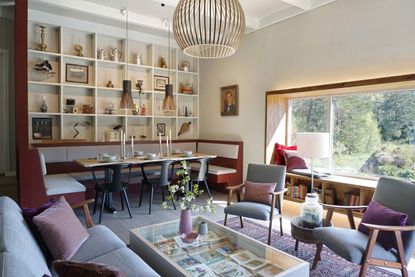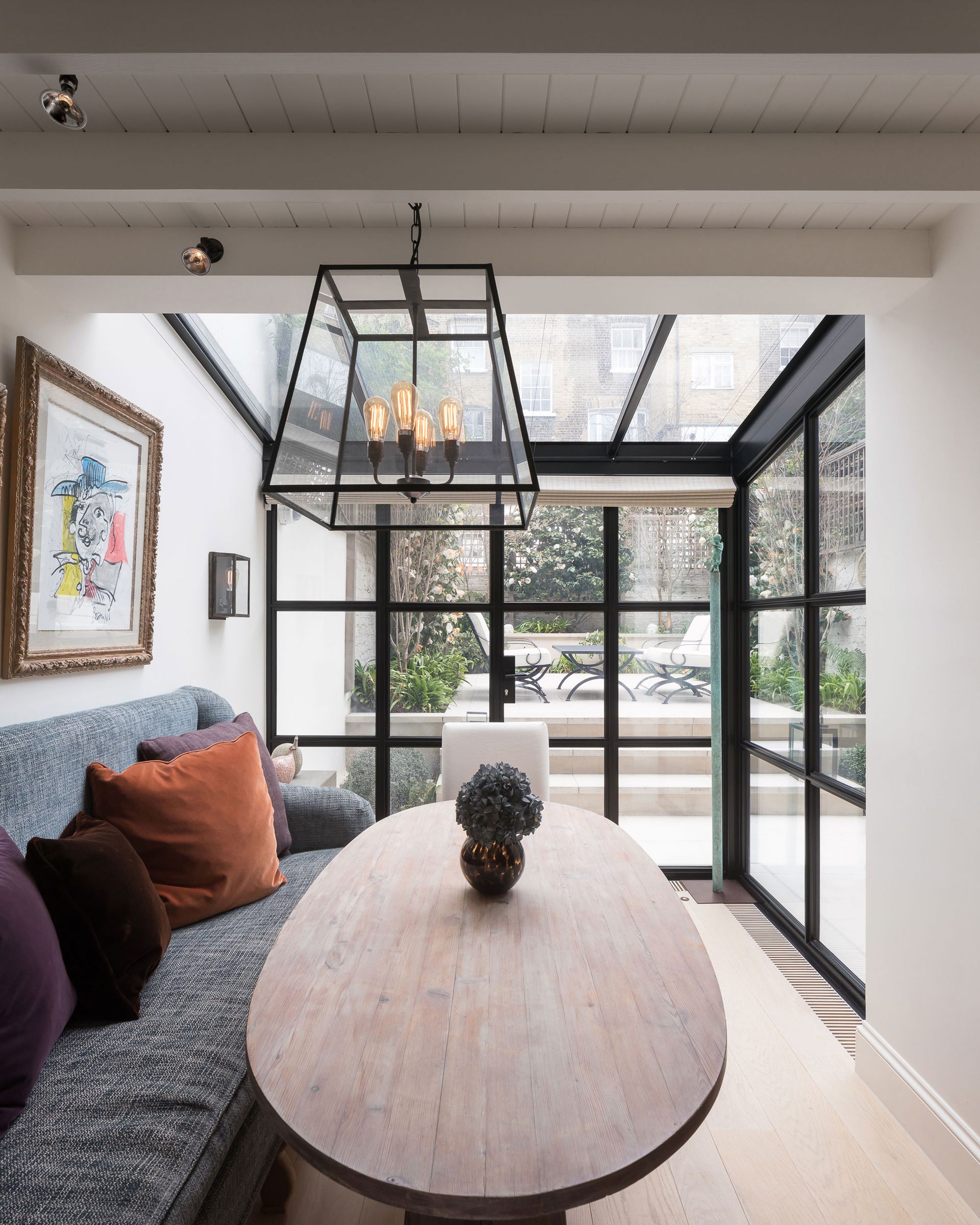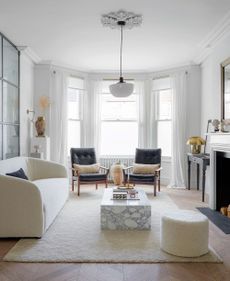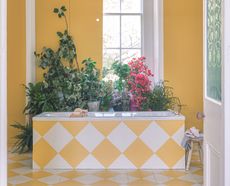Prospect-refuge theory explained - the rediscovered design approach that can change your life for the better
Designer Oliver Heath explains that prospect-refuge theory shouldn't be overlooked in your home's layout and design


What if we were to tell you that prospect-refuge theory, a concept that has been around for 50 years, could make you feel more calm? That, with just a few tweaks to your home design you could enjoy a wellness boost, take more pleasure from your surroundings and just live a happier, more productive life? Yes, prospect-refuge theory really is that good.
But why now, after half a century being talked about only in esoteric lecture halls, is modern interior design beginning to understand this theory's value? Partly, this is a logical next step from the ubiquitous trend for houseplants, from how we've all experienced the joy in caring for foliage at home. As biophilic design principles take root in plant pots all around the world, so it's only to be expected they'd grow into an appreciation for the wonders of prospect-refuge.
While these principles may have only had a name put to them back in the 1970s, it’s something that has existed as long as humans have. ‘For hundreds of thousands of years, humans have existed in very close connection to nature as a means to survive, thrive, and flourish,’ explains biophilic expert Oliver Heath. Essentially, we're hardwired to look at greenery and see a means to food and therefore life, so feel comforted and happy. ‘A lot of our reactions to spaces are based on this sort of evolutionary backdrop,’ Oliver says. ‘ It's a genetic inheritance that is still relevant to us today, even though we now find ourselves in much more complex, built-up urban geometric spaces.’
In essence, these involuntary, inherited responses may be affecting how weenjoy our homes as environments, and making a few small changes based on this theory can enhance everything about how you live. With the help of Oliver, we drill down into how one such evolutionary theory, prospect-refuge, can be used to design our homes and view them in a different light.

Limehouse cottage, available to book through Unique Homestays, has a panoramic view of mountains, lakes and meadows in County Kerry, Ireland.
What is prospect-refuge theory?
Biophilic design - the approach that sees us mimicking the colors and feel of nature in our homes in order to make us happy in the same way that, say, the sight of green fields does - consists of 14 patterns. Both prospect and refuge feature individually as patterns, but they’re often combined for their complimentary values.
Prospect looks at the idea that when you’re in a space, you want to be able to see it clearly, understand it and be aware of any threats, as well as opportunities. Refuge, meanwhile, focuses on the feeling of being safe, surrounded, and protected.
‘Imagine back to cave people,’ says Oliver, ‘where the ideal position would be to sit in a cave, overlooking a landscape. We could feel safe knowing that nothing was behind us, while looking outwards over a landscape where we could see potential predators or prey. There’s a sense of safety and security by being surrounded on three sides, with a single point of focus looking out - and these things remain with us.’
The biophilic design idea of prospect-refuge theory manifests itself in how we use all kinds of spaces, not just in our homes, but out in public too. From town squares and gardens to even shopping malls and train stations, people prefer to position themselves at the edges, looking into the center. ‘We feel that sense of safety and security when we're looking down onto a space from appointed safety where nobody can see us, and we’ve got something behind us, so we don't feel anyone's going to creep up on us.’
‘It’s calming and restorative, and finding a place to relax and recuperate is probably more important than ever right now because we're constantly bombarded with requests for sensory stimulation,’ Oliver explains.

A chair by a large window, as seen here in this build by modern cabin-makers Koto Design, is the perfect spot for prospect over your surroundings.
How can this be practically applied to your home design?
Thankfully, it's super-easy to apply prospect-refuge theory to your home, and a little care with your living room ideas can be all that is needed. ‘It can be as simple as having a little sofa next to a window, and actually one of my favorite kind of prospect refuge devices is the window seat,’ says Oliver. Prospect itself, can come in a few forms, so finding an area that has either long, open, uninterrupted views; elevated views that you can look down over spaces; or big expansive views where you get that overarching sense of a landscape can all work for your relaxation space.
‘It's good to have something to look at,’ ventures Oliver, ‘such as the gentle movement of nature. This could be water, trees, plants or grasses out in your garden.'
These garden ideas are based on a biophilic design principle called ‘soft fascination, that sense of movement found in nature that just demands an effortless attention and allows you to drift off for a moment. 'Daydreaming isn’t a bad thing – you shouldn’t expect the human mind to be engaged for 12-16 hours a day, it was never designed to be as active as contemporary society demands.’
Your spot of refuge, on the other hand, benefits from being separated from a wider living space to give you privacy. This might be a separate room, an area demarcated in a broken-plan scheme, or even just using a simple device like a high-backed armchair to create that sense of being enclosed. Lower ceilings in relaxation areas can help too.

‘Open plan living spaces are a bit of a bugbear of mine,’ says Oliver. ‘I think a living room should just be a refuge space that nobody walks through, somewhere you can just recoup without the risk of somebody barging through to get to the kitchen. Using refuge principles, a relaxing space shouldn’t be used for your home’s circulation.’
Because of the nature of prospect-refuge theory, finding a place to relax might come innately to you, and you'll be drawn to areas of your home which benefit from these biophilic design principles. But, identifying them from the outset means that you can design in these pockets of space across your home, ensuring everyone has a place to retreat to, where they can relax, feeling safe and with prospect over your home and garden.
Be The First To Know
The Livingetc newsletter is your shortcut to the now and the next in home design. Subscribe today to receive a stunning free 200-page book of the best homes from around the world.

Hugh is the Editor of Livingetc.com. From working on a number of home, design and property publications and websites, including Grand Designs, ICON and specialist kitchen and bathroom magazines, Hugh has developed a passion for modern architecture, impactful interiors and green homes. Whether moonlighting as an interior decorator for private clients or renovating the Victorian terrace in Essex where he lives (DIYing as much of the work as possible), you’ll find that Hugh has an overarching fondness for luxurious minimalism, abstract shapes and all things beige. He’s just finished a kitchen and garden renovation, and has eyes set on a bathroom makeover for 2024.
-
 How to Thaw a Frozen Pipe — Learn Everything You Need to Know in 5 Minutes With This Guide
How to Thaw a Frozen Pipe — Learn Everything You Need to Know in 5 Minutes With This GuideWinter storm caught you off guard? We asked an expert — just how do you thaw a frozen pipe?
By Hugh Metcalf Published
-
 The 12 Very Best Silk Bedding Pieces — As Our Style Editor Says: 'It's What Dreams Are Made Of!'
The 12 Very Best Silk Bedding Pieces — As Our Style Editor Says: 'It's What Dreams Are Made Of!'Slumber in lustrous luxury with the very best silk bedding sheets, duvets, pillowcases, and more — your sleep score will thank us later
By Julia Demer Published
-
 Little changes, big difference - easy ways to eco-boost your home from leading experts in design
Little changes, big difference - easy ways to eco-boost your home from leading experts in designSustainable choices have never been easier to make than with these eco design tips from the experts
By Pip Rich Published
-
 Florist Angela Maynard on how to care for dried flowers and how to style them in a modern home
Florist Angela Maynard on how to care for dried flowers and how to style them in a modern homeKnowing how to care for dried flowers means you can have stylish arrangements that last for years. Author and florist Angela Maynard shares her tips
By Angela Maynard Last updated
-
 Farrow & Ball's Joa Studholme explains exactly how to use color at home for 2022
Farrow & Ball's Joa Studholme explains exactly how to use color at home for 2022Design legend Joa Studholme explains which colors to use at home in 2022, and just how to use them, too
By Pip Rich Published




